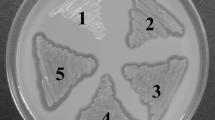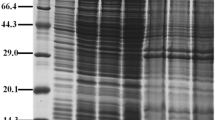Abstract
Expression of the pCloDF13-encoded bacteriocin-release protein (BRP) results in the release of periplasmic proteins into the culture medium. The BRP-mediated release of a periplasmic protein was investigated and optimized. As a periplasmic model protein, the 50-kDa dimeric E. coli fimbrial molecular chaperone FaeE was used. Plasmids were constructed for the simultaneous expression of the BRP and FaeE, controlled by independently inducible promoters. The efficiency of FaeE release increased when the BRP was targeted by the unstable murein lipoprotein signal peptide, instead of by its own stable signal peptide. Furthermore, optimal efficacy of FaeE release was found when cells of E. coli strain C600 were used, which harboured one plasmid encoding both FaeE and BRP instead of two separate plasmids and which were cultured at 37°C in broth supplemented with MgCl2. Maximal production levels of 21 mg FaeE/l culture were obtained.
Similar content being viewed by others
References
Aono R (1988) Cultivation conditions for extracellular production of penicillinase by Escherichia coli carrying pEAP31 on a semi-large scale. Appl Microbiol Biotechnol 28:414–418
Birnboim HC, Doly J (1979) A rapid alkaline extraction procedure for screening recombinant plasmid DNA. Nucleic Acids Res 7:6727–6738
Blanchin-Roland S, Masson JM (1989) Protein secretion controlled by a synthetic gene in Escherichia coli. Protein Eng 2: 473–480
Bollag MD, Edelstein SJ (1991) Protein methods. Wiley-Liss, New York
Cavard P, Bernadac A, Pages JM, Lazdunski C (1984) Colicins are not transiently accumulated in the periplasmic space before release from coliconogenic cells. Biol Cell 51:79–86
Cavard D, Baty D, Howard SP, Verhey HM Lazdunski C (1987) Lipoprotein nature of the colicin A lysis protein: effect of amino acid substitutions at the site of modification and processing. J Bacteriol 169:2187–2194
Cavard D, Lazdunski C, Howard SP (1989) The acylated precursor form of the colicin A lysis protein is a natural substrate of the DegP protease. J Bacteriol 171:6316–6322
De Graaf FK, Oudega B (1986) Production and release of cloacin DF13 and related colicins. Curr Top Microbiol Immunol 125:183–205
Driver S, Lee C, Guilford J, Price R (1992) Stripping and reprobing protocols. ECL Highlights 4:12
Gogstad GO, Krutnes M-B (1982) Measurement of protein in cell suspensions sing the Coomassie brilliantblue dye-binding assay. Anal Biochem 126:355–359
Ho SN, Hunt HD, Horton RM, Pullen JK, Pease LR (1989) Site-directed mutagenesis by overlap extension using the polymerase chain reaction. Gene 77:51–59
Author information
Authors and Affiliations
Rights and permissions
About this article
Cite this article
van der Wal, F.J., ten Hagen-Jongman, C.M., Oudega, B. et al. Optimization of bacteriocin-release-protein-induced protein release by Escherichia coli: extracellular production of the periplasmic molecular chaperone FaeE. Appl Microbiol Biotechnol 44, 459–465 (1995). https://doi.org/10.1007/BF00169944
Received:
Revised:
Accepted:
Issue Date:
DOI: https://doi.org/10.1007/BF00169944




